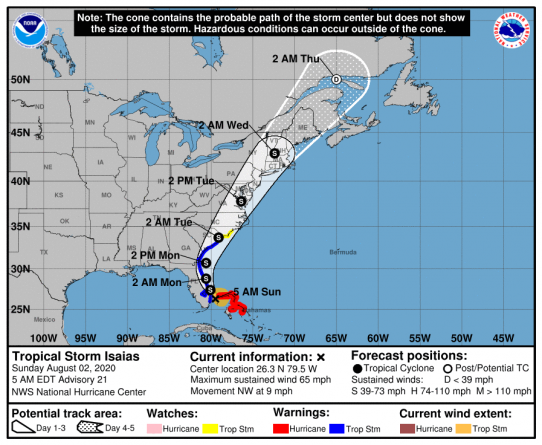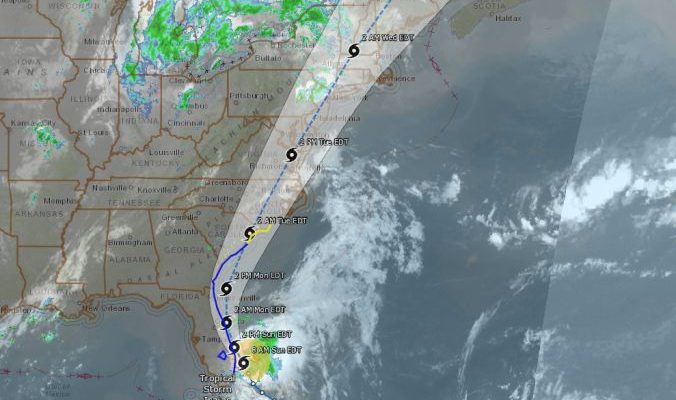The latest Isaias bulletin from the National Weather Service indicates that Delaware could see two to five inches of rain, gusty winds, and minor to isolated moderate river flooding early next week.
BULLETIN
Tropical Storm Isaias Intermediate Advisory Number 21A
NWS National Hurricane Center Miami FL AL092020
800 AM EDT Sun Aug 02 2020
…HEAVY RAINFALL AND GUSTY WINDS CONTINUE OVER THE NORTHWESTERN
BAHAMAS…
…TROPICAL STORM CONDITIONS CLOSE TO THE EAST COAST OF FLORIDA…
SUMMARY OF 800 AM EDT…1200 UTC…INFORMATION
———————————————-
LOCATION…26.5N 79.5W
ABOUT 40 MI…70 KM ESE OF WEST PALM BEACH FLORIDA
ABOUT 155 MI…245 KM SSE OF CAPE CANAVERAL FLORIDA
MAXIMUM SUSTAINED WINDS…65 MPH…100 KM/H
PRESENT MOVEMENT…NW OR 325 DEGREES AT 8 MPH…13 KM/H
MINIMUM CENTRAL PRESSURE…996 MB…29.42 INCHES
WATCHES AND WARNINGS
——————–
CHANGES WITH THIS ADVISORY:
The Hurricane Warning for the Northwestern Bahamas has been
discontinued.
SUMMARY OF WATCHES AND WARNINGS IN EFFECT:
A Storm Surge Watch is in effect for…
* Jupiter Inlet to Ponte Vedra Beach Florida
* Edisto Beach South Carolina to Cape Fear North Carolina
A Tropical Storm Warning is in effect for…
* Hallandale Beach Florida to South Santee River South Carolina
* Lake Okeechobee
A Tropical Storm Watch is in effect for…
* North of South Santee River South Carolina to Surf City North Carolina
Interests elsewhere along the southeast and mid-Atlantic coasts of the United States should monitor the progress of Isaias. Additional watches or warnings may be required later today.
A Storm Surge Watch means there is a possibility of life-threatening inundation, from rising water moving inland from the coastline, in the indicated locations during the next 48 hours.
For a depiction of areas at risk, please see the National Weather Service Storm Surge Watch/Warning Graphic, available at hurricanes.gov.
A Tropical Storm Warning means that tropical storm conditions are expected somewhere within the warning area, generally within 36 hours.
A Tropical Storm Watch means that tropical storm conditions are possible within the watch area, generally within 48 hours.
For storm information specific to your area in the United States, including possible inland watches and warnings, please monitor products issued by your local National Weather Service forecast office. For storm information specific to your area outside of the United States, please monitor products issued by your national meteorological service.
DISCUSSION AND OUTLOOK
———————-
At 800 AM EDT (1200 UTC), the center of Tropical Storm Isaias was located by an Air Force Reserve reconnaissance aircraft and NOAA Doppler weather radars near latitude 26.5 North, longitude 79.5 West. Isaias is moving toward the northwest near 8 mph (13 km/h). A general northwestward motion is expected today, followed by a north-northwestward motion tonight. A turn toward the north and north-northeast is anticipated on Monday and Tuesday with an increase in forward speed. On the forecast track, the center of Isaias will move near or over the east coast of Florida today through late tonight. On Monday and Tuesday, the center of Isaias will move from offshore of the coast of Georgia into the southern mid-Atlantic states.
Reports from an Air Force Reserve Hurricane Hunter aircraft indicated that the maximum sustained winds remain near 65 mph (100 km/h) with higher gusts. Little change in strength is expected during the next couple of days.
Tropical-storm-force winds extend outward up to 115 miles (185 km) from the center. During the past couple of hours, a wind gust to 55 mph (89 km/h) was reported at Freeport, Grand Bahama Island, and a Weatherflow observing site at Junno Beach Pier, Florida, measured a wind gust to 47 mph (76 km/h).
The latest minimum central pressure reported by reconnaissance aircraft is 996 mb (29.42 inches).
HAZARDS AFFECTING LAND
———————-
Key messages for Isaias can be found in the Tropical Cyclone Discussion under AWIPS header MIATCDAT4, WMO header WTNT44 KNHC, and on the web at www.hurricanes.gov/text/MIATCDAT4.shtml.
STORM SURGE: The combination of a dangerous storm surge and the tide will cause normally dry areas near the coast to be flooded by rising waters moving inland from the shoreline. The water could reach the following heights above ground somewhere in the indicated areas if the peak surge occurs at the time of high tide…
North Miami Beach FL to Jupiter Inlet FL…1-3 ft
Jupiter Inlet FL to Ponte Vedra Beach FL…2-4 ft
Ponte Vedra Beach FL to Edisto Beach SC…1-3 ft
Edisto Beach SC to Cape Fear NC…2-4 ft
The deepest water will occur along the immediate coast in areas of onshore winds, where the surge will be accompanied by large waves. Surge-related flooding depends on the relative timing of the surge and the tidal cycle, and can vary greatly over short distances.
For information specific to your area, please see products issued by your local National Weather Service forecast office.
WIND: Tropical storm conditions will continue over portions of the Northwestern Bahamas through this morning.
Tropical storm conditions are expected to spread northward along the coast of Florida within the warning area through tonight.
These conditions will spread northward along the coasts of Georgia and South Carolina within the warning area on Monday.
Tropical storm conditions are possible in the watch area in South and North Carolina beginning Monday night and Tuesday.
RAINFALL: Isaias is expected to produce the following rain accumulations:
Northwest Bahamas: 4 to 8 inches, with isolated maximum totals of 12 inches.
Eastern Florida: 2 to 4 inches, with isolated maximum totals of 6 inches.
Northeast Florida and coastal Georgia: 1 to 3 inches.
Carolinas and the mid-Atlantic, including the southern and central Appalachians: 2 to 5 inches, with isolated maximum totals of 7 inches.
Southeast New York and much of New England: 2 to 4 inches, with isolated maximum totals of 6 inches.
Heavy rainfall from Isaias could result in potentially life-threatening flash flooding in the Bahamas and flash and urban flooding along the East Coast of the United States. Minor to
isolated moderate river flooding is possible across portions of the Carolinas and Mid-Atlantic.
SURF: Swells generated by Isaias are affecting portions of the Central and Northwest Bahamas and will spread northward along the east coast of Florida and the southeastern United States coast during the next day or two. These swells are likely to cause life-threatening surf and rip current conditions. Please consult products from your local weather office.
TORNADOES: The potential for a couple tornadoes will begin along coastal South Carolina during the late afternoon and evening on Monday, spreading across eastern North Carolina on Monday night.


